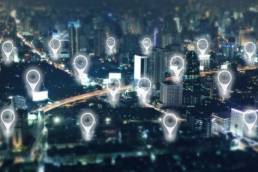Becoming ‘data-driven’ continues to be a priority for businesses in many different sectors. And nowhere is this more prevalent than in mapping and navigation.
For many companies – particularly those operating in logistics and transportation – having sophisticated location intelligence is an essential component of their day-to-day work. However, many other industries are beginning to benefit from the insights it provides too.
Let’s take a closer look at some business needs we serve here at Local Eyes.
From Fold Outs To Live Updates
Not too long ago, maps were ’analogue’ objects. They were about getting from A to B. Any additional details – incidents, heavy traffic, road closures etc – were discovered en route.
However, as the digital age dawned, mapmakers saw an opportunity to use technology to provide greater detail – to show real-time routes and to chart progress. As time went on, this expanded to include speed limits, congestion, alternative routes.
For weekend explorers, and day-trippers, Google Maps continues to be the go-to resource. But for logistics or mission critical businesses, precision is paramount.
Overcoming Logistical Challenges
Keeping the wheels of commerce turning means providing more than just a sense of ‘which bridges to avoid driving under’.
Say you run a delivery or ride hailing company. You have a fleet of 200 vehicles out at any time. A lot can go wrong – things that are beyond your and your drivers’ control.
Being able to plan ahead is one thing, but having the ability to react in real-time can make all the difference – to everything from your delivery/fare capacity to fuel costs, as well as your brand’s reputation and ultimately, its profitability.
Location Technology Keeps Public & Emergency Services Running
Real-time mapping and navigation are also crucial for public services. For example, waste management staff often need to follow specific routing plans. And when you consider how fast emergency services – such as fire departments and ambulance services – need to respond, some advanced calculations or algorithms and live insights can often be a matter of life and death.
In more remote areas, which are largely unmapped by mainstream software providers (such as war zones and conflict areas), being able to tap into a live satellite feed can give military teams a distinct advantage in combat. In a similar way organisations with security concerns – such as NGOs working in remote areas – can’t use “free”Maps as data quality and consistency is haphazard, and there are privacy concerns: unlike the data we provide.
Location-Based Insights and Services
Location Intelligence has a critical role to play in everything from telematics (analysing driver behaviour for insurance companies) to advertising (geotargeting and understanding buyer behaviour using anonymised mobile phone data), as well as many other areas – such as retail real estate decisions.
To give an example, say a well-known international coffee chain (no names mentioned) is looking to expand into Europe. By engaging with data presented visually on a map, they can locate underserved areas and ensure that their real estate and other capital investments are deployed in the most cost-effective way – helping them choose retail locations that are likely to be successful.
Our Aims & Ambitions
As we’ve outlined above, we’ve seen how location technology drives business growth in the last few years – which is why the Local Eyes team remains committed to becoming an international market leader in map data and location services .
We continue to partner with specialist service providers whose assets complement our own.
In addition to our own range of geospatial products, we partner with HERE Technologies. We also work closely with software developers looking to integrate map- and location-based APIs into their apps and digital services – from a range of different sectors.
Overall, given the sheer amount of location data that’s accessible and available – and the benefits and impact it can provide for so many businesses – it’s clear that the need for it will only increase.
Although we operate in what’s essentially a niche market (currently) you only need to look at the trends in digital transformation – from Internet of Things, Artificial Intelligence, Machine Learning, and Smart Cities – to appreciate how big the opportunity will be.
Ultimately, while our role may be a small, supporting one, we like to think we’re helping bring all kinds of innovations to fruition through what we do.



